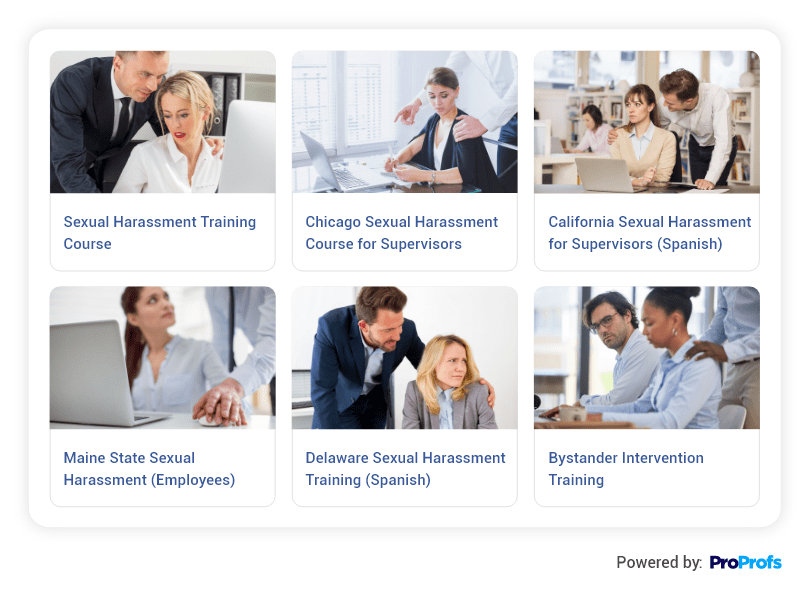It is always important to invest in employee training programs because they are tied to so many metrics.
But what’s more important is investing in the right training programs for employees aligned with your learning goals and business objectives.
Here’s a list of training topics for employees I’ve curated for you based on my experience in the learning & training industry.
List of Training Programs for Employee Development
1. Sexual Harassment Training
“Our lives begin to end the day we become silent about things that matter.” – Martin Luther King Jr.
According to the U.S. Equal Employment Opportunity Commission (EEOC), 25% to 85% of women and 20% to 60% of men experience sexual harassment in the workplace.
Sexual harassment training can help combat and reverse this trend to a great extent.
Sexual harassment training is a type of compliance training that educates employees and supervisors about what constitutes sexual harassment in the workplace and how to prevent and respond to incidents of sexual harassment.
The content of sexual harassment training typically includes information about the various forms of sexual harassment. For example, this training in my organization generally covers the legal and policy frameworks that prohibit such behaviors, the consequences of engaging in or condoning sexual harassment, and practical strategies for preventing and responding to incidents of sexual harassment.
The main idea behind sexual harassment training is to educate and empower participants about appropriate and inappropriate workplace behaviors. This, in turn, enables organizations to build a respectful and safe professional environment.
Benefits of Sexual Harassment Training
- Awareness of what constitutes sexual harassment
- Ability to respond to instances of harassment
- Prevention and mitigation of incidents of sexual harassment
- Reduced liability and legal risks for organizations
- A culture of respect, trust, and accountability
- Well-being and mental health of individuals
- Open communication and reporting of incidents
- Understanding of what is and isn’t retaliation
- Knowledge of how to respond as a victim or bystander

2. Leadership & Management Training
“A boss has the title, a leader has the people.” — Simon Sinek
Leadership & management training provides the skills and knowledge necessary to become effective managers and leaders. This training covers topics such as communication skills, decision-making, problem-solving, team-building, motivation, and performance management.
For example, whenever my organization deploys leadership and management training, employees are provided with the tools they need to effectively manage and lead teams, develop and implement strategies, and drive positive change within their organizations.
The aim of this training is to develop modern leaders and managers who are more collaborative, communicative, and empathetic compared to traditional leaders. It emphasizes emotional intelligence, continuous learning, flexibility and adaptability, and a people-centered approach.

Benefits of Leadership & Management Training
- Skills to effectively convey messages, build rapport, and foster better relationships
- Increased employee engagement resulting in satisfaction and productivity
- Skills to handle conflicts and manage difficult situations effectively
- Change management within an organization
- Identifying and developing future leaders through succession planning
- Creativity and innovation by thinking outside the box and inspiring teams
- Effective decision-making aligned with organizational goals
I truly believe that onboarding is an art. Each new employee brings with them the potential to achieve and succeed. To lose the energy of a new hire through poor onboarding is an opportunity lost. – Sarah Wetzel, Director of Human Resources, engage:BDR
Simplify Employee Training & Tracking
Train, track, and manage employees effortlessly.
3. Onboarding Training
Did you know that organizations with strong onboarding processes can increase new hire retention by 82%?
A formal onboarding training program provides an effective way to acclimate new hires to their new roles quickly.
This program familiarizes them with their job responsibilities, the software and hardware they will be using at work, company policies, mission, vision, team structure, and departments.
The duration of the program may vary depending on the nature of the job and the amount of information that needs to be covered. From what I’ve seen, onboarding is not limited to the first few days or weeks of an employee’s tenure. Rather it is an ongoing process that can involve multiple stages and checkpoints throughout the first year and beyond.
By assigning an onboarding training program, you can ensure that your new hires are set up for success.


Benefits of Onboarding Training
- A strong connection between new hires and the organization
- A clear roadmap for accelerated productivity based on job expectations
- Improved employee retention through a sense of belonging and loyalty
- Reduced time to competency by delivering targeted, role-specific training
- Overall job satisfaction by addressing challenges and developing necessary skills
- A positive company culture and shared values
- Team collaboration through structured networking and relationship-building
- Reduced stress and anxiety associated with the ambiguity of starting a new job
- Smooth transition for new employees
Watch: How to Create an Employee Onboarding Training Program
4. Safety Training
“Safety brings first aid to the uninjured.” – F.S. Hughes
Workplace safety serves as the first line of defense for employees and organizations.
Let me give you a real-life example of how serious it can be.
Recently, a New Hampshire-based roofing contractor faced a penalty of $234k for exposing workers to fall hazards. The company was earlier penalized for failing to protect its employees against lethal falls.
Instances like this make safety training such as OSHA a must.
Watch: What is OSHA Compliance Training? Requirements & Benefits
But what exactly is a safety training program?
Safety training programs educate employees on how to recognize and prevent workplace hazards and how to respond to emergency situations. After the training, employees become aware of the potential dangers in their work environment and they are equipped with the knowledge and skills to work safely and avoid accidents and injuries.
Such programs can cover a variety of employee training courses, depending on the specific needs of an organization and the industry in which it operates. Some common focus areas include:
- Hazard Identification and Risk Assessment
- Personal Protective Equipment (PPE)
- Emergency Response
- Fall Prevention
- Ladder Safety
- Fire Extinguisher Safety
- Workplace Ergonomics


Benefits of Safety Training
- Improved employee morale
- Enhanced productivity through reduced risks & absence of disruptions
- Cost savings as businesses can avoid expenses related to compensations
- Improved business reputation through a safe work culture
- Compliance with safety regulations and industry standards
- Increased employee retention
- Better emergency preparedness through trained staff
Here’s a case study on how Tupperware successfully deployed safety training across its European plants.
5. Compliance Training
Another type of training that is crucial for most organizations is compliance training. It educates employees about laws, regulations, and company policies relevant to their industry and job functions.
Compliance training aims to ensure that employees are aware of their responsibilities and obligations and understand the consequences of non-compliance.
Here are some eye-opening statistics on compliance training that I find significant:
- 23% of organizations have no formal compliance training
- 40% of companies rate their compliance training as basic or reactive
- Non-compliance can cost an organization about $14.82 million per year
Remember: The cost of non-compliance can manifest in the form of hefty penalties and fines, which erode a company’s profits and tarnish its reputation. It can also result in an unhealthy audit trail.
Therefore, compliance training is a must and it should cover topics such as data protection, anti-bribery and corruption, anti-money laundering, workplace harassment, health and safety, HIPAA, OSHA, and many others.



Most organizations provide such training to employees at regular intervals, generally once a year, to ensure that they are up-to-date with the latest laws and regulations.
Benefits of Compliance Training
- Staying abreast of all legal guidelines and industry-specific regulations
- Reduced risk of costly lawsuits and reputation damage
- Promoting a culture of compliance
- Prevention of unethical behavior, fraud, and misconduct
- Safeguarding both customers and the organization
- Enhanced employee knowledge, skills, and confidence
- Improved performance, productivity, and job satisfaction
Watch: What Is Compliance Training? Requirements & Benefits
6. Technical Skills Training
According to LinkedIn, technical skills are among the top in-demand hard skills.
So, training in technical roles matters a lot.
Let me elaborate.
Technical skills training refers to employee training programs that focus on developing technical expertise in participants.
This type of training is role or industry-specific and typically includes hands-on practice, demonstrations, and lectures to teach employees how to use various equipment, software programs, tools, and procedures.
Topics covered under this program include computer software, programming languages, machine operation, and safety procedures.
The training is particularly important in industries that rely heavily on technology or have complex processes requiring specialized skills.


Benefits of Technical Training
- Critical thinking and problem-solving abilities to find quick solutions
- Enhanced teamwork and collaboration
- Improved job performance and productivity among employees
- Adaptability to tools and technology advancements in their field
- Increased employee morale and job satisfaction
- Increased job prospects in various industries
Let’s continue and look at the other types of employee training I’ve lined up for you.
7. Soft Skills Training
Just like technical skills, soft skills are among the core skills expected of employees and are equally important.
These skills, sometimes known as people skills or emotional intelligence, play a vital role in how employees communicate, work, and get along with each other.
In my career, I came across many employees who are top performers at the individual level, but they fare poorly when it comes to interpersonal skills and teamwork. Such employees should particularly work on their soft skills.
Employees with excellent interpersonal skills know how to communicate well, collaborate with others, resolve conflicts, or handle customers.
This is why you need to train your employees on soft skills.
Look at the following example courses:


This type of training focuses on developing non-technical skills and attributes, such as communication, teamwork, problem-solving, leadership, time management, and emotional intelligence, that are important for workplace success.
It is particularly important in industries where customer service and interpersonal interactions are critical for success, such as hospitality, healthcare, education, and business services.
Benefits of Soft Skills Training
- Improved communication skills leading to better collaboration and teamwork
- Enhanced problem-solving abilities for effective decision-making
- Increased emotional intelligence for better relationship-building
- Boosted leadership skills leading to more effective management
- Improved adaptability and flexibility in dealing with workplace changes
- Enhanced personal development and self-awareness for career growth
8. Product or Service Training


“Quality in a service or product is not what you put into it. It is what the customer gets out of it.” – Peter Drucker
Product/service training educates employees on products or services. It is designed to create awareness around flagship products and services and build a knowledgeable workforce so that they can work efficiently or provide better customer service.
With product training, you can help your staff learn the minute details of a product or service.
For example, salespersons at my company are well-trained and versed in our software products. They can professionally handle any query customers throw at them. They are adept at prospect education, active listening, communication, storytelling, and problem-solving. The majority of the credit goes to the extensive training these sales professionals undergo at different points in time.
Product and service training may include educating your employees on product features, technical specifications, pricing, target markets, use cases, customer needs, competitive landscape, and sales techniques.
In addition, product/service training can help improve customer satisfaction and loyalty by ensuring that employees can provide accurate and helpful information to customers.
For example, in a survey carried out in the USA, 91% of respondents agreed that knowledgeable store employees made shopping easier and desirable.
Benefits of Product & Service Training
- Improved customer satisfaction through employees trained in product & service
- Increased sales with convincing sales pitches, closing more deals
- Reduced employee turnover by demonstrating you care about employees’ career development
- Enhanced brand image as well-trained employees represent your brand better
- Trained employees feel more confident in their abilities
- Companies can bank on their workforce to generate more revenue
9. Sales Training
The best salespeople think like clients, not salespeople.
Did you know that for the majority of sales professionals, 84% of sales training is forgotten after three months? This is mainly due to a lack of information retention.
That’s why continuous training is necessary.
Sales training is a kind of training program that helps individuals develop the skills and knowledge necessary to succeed in a sales role.
The training covers diverse topics, such as making a sales pitch, handling sales objections, nurturing sales leads, and closing sales.


With this training, you can improve sales performance, increase revenue, and enhance customer satisfaction. This is because the training provides sales teams with the capabilities they need to effectively communicate the value of their products or services to customers.
Benefits of Sales Training
- Improved product knowledge and understanding
- Better understanding of customer needs and buying behaviour
- Increased sales performance and productivity
- Enhanced sales techniques and closing skills
- Enhanced communication and listening skills
- Increased confidence and motivation
- Effective objection handling and negotiation skills.
- Better time management and prioritization
- Enhanced relationship-building and trust-building abilities
- Improved sales forecasting and pipeline management
- Increased customer satisfaction and loyalty
- Reduced sales turnover and attrition
Want to upskill your workforce with effective online sales training?
10. Diversity Training
The famous American fast-food restaurant chain, KFC, has invested in diversity and inclusion training to develop diverse leaders and franchisees. This is intended to make the brand a true reflection of its team members and customers’ demographics, besides giving greater weightage to diverse perspectives and making KFC a center for positive change.
Do you also want to make a difference by building an inclusive work culture?
Then let me tell you that diversity training is the answer.
Diversity training focuses on increasing awareness and understanding of diversity and inclusion in the workplace. This program usually covers topics like cultural awareness, unconscious bias, conflict resolution, and workplace harassment.
Like other compliance training topics, diversity training is held at regular intervals. For example, in my organization, all employees undergo this training at least once annually.
The training seeks to create a safe and respectful workplace by providing individuals with the knowledge and skills needed to get along with colleagues from diverse backgrounds.
The training aims to create a positive work environment that values and respects individual differences, resulting in a more inclusive workplace culture and improved organizational performance.
Benefits of Diversity Training
Here are some benefits of diversity training in bulleted points:
- Promotes appreciation of diverse backgrounds, cultures, and perspectives
- Helps prevent discrimination, harassment, and bias in the workplace
- Improves communication, empathy, and social skills among employees
- Fosters creativity and innovation by encouraging diverse viewpoints and ideas
- Enhances teamwork and collaboration by breaking down barriers between employees
- Improves employee morale and job satisfaction by creating a more inclusive workplace
- Helps attract and retain diverse talent by showing a commitment to diversity
11. Quality Assurance


Quality assurance is vital for business growth as it increases customer satisfaction, reduces waste and costs, and helps gain a competitive advantage.
Quality assurance training is another type of employee training program that focuses on ensuring that products and services meet or exceed customer expectations. Generally, the training deals with quality control, management, and improvement topics.
To give you an example, product developers and product managers in my organization are regularly trained on the software products they handle. This is to ensure they meet predefined quality standards and customer requirements.
By conducting code reviews, testing, bug tracking, and quality assurance processes, these professionals make sure our products meet specified functional requirements and perform reliably.
A quality assurance training program includes instructions on the principles and practices of quality assurance, such as statistical process control, root cause analysis, and continuous improvement.
Participants in this training learn how to identify defects, measure and analyze quality data, and implement corrective actions to improve processes and products.
Benefits of Quality Assurance Training
- Compliance with industry standards
- Prevention of defects and mistakes in production processes
- Consistent performance standards for assessors
- Improves the overall effectiveness of quality assurance processes
- Trust and credibility with customers, partners, and stakeholders
- Enhanced customer satisfaction by maintaining high quality standards
- Cost savings by reducing the occurrence of defects and rework
12. HR Training
The HR team is the lifeblood of any organization.
They are responsible for bringing in new talent, managing manpower, and promoting a mindset of continuous growth. Also, lately, they have become a strategic partner for businesses.
But the question is: who will take charge of their growth and development?
HR is often seen as a process-driven, operational department that manages the employee lifecycle, but it should play a larger role in developing the company’s people strategy and culture.
While HR manager training must cover essential hard skills, HR professionals need a mix of soft and hard skills to be successful and make an impact across the organization.
HR training can help you here by providing your HR teams with the necessary skills and knowledge to perform their job responsibilities effectively.
You can train your HR teams on onboarding new hires successfully, leadership development, compliance training, and skills training. HR training is important as it impacts employee performance and productivity while also fostering a positive work culture and promoting career growth.



Successful HR training programs require effective communication, tailored content, and ongoing evaluation and feedback systems to ensure they meet the needs of both the employees and the organization.


Benefits of HR Training
- Experiential learning opportunities to develop and showcase top talent
- Better understanding & alignment with a company’s objectives
- Enhanced knowledge and skills of technological advancements and evolving strategies
- Improved talent management through HR best practices
- Increased engagement, improved productivity, and profitability
- Compliance with laws, regulations, and industry standards
13. Technology Training
“It’s not that we use technology, we live technology.” – Godfrey Reggio
The next type of training I’ve for you is technology training.
It is broad in scope and encompasses training related to technology as a whole. It not only includes the practical skills necessary to use specific technologies but also covers a deeper understanding of how technology works, its applications, and its impact on various industries and society.
Examples of technology training topics include information technology (IT), artificial intelligence (AI), deep learning and neural networks, natural language processing (NLP), mobile app development, network security, data science, and cloud computing.
Technology training explores the theoretical and conceptual aspects of technology, providing learners with knowledge and insights about different types of technologies, their functions, capabilities, and potential use cases.


Benefits of Technology Training
- Technology training helps individuals become more digitally literate
- Improved productivity through the knowledge and skills to use technology effectively
- Increased job opportunities due to a competitive advantage in the job market
- Better problem-solving ability by using digital tools and resources
- It empowers individuals to improve their efficiency and time management skills
- Access to information and resources to constantly learn and stay updated in their field
- Increased creativity & innovation by exploring and experimenting with various technologies
14. Coaching


Coaching is a type of employee training program that focuses on enhancing employee performance, engagement, and satisfaction. It involves a manager or an experienced colleague working closely with the employee to help them improve their skills and performance in their role.
The coaching process typically includes regular one-on-one meetings and feedback sessions, where clear objectives are set and progress is discussed.
The goal of coaching is not only to develop the employee’s skills, but also to boost their job satisfaction and overall success.
Coaching as a training program is implemented through a collaborative and ongoing process. A leader who is skilled in coaching partners with employees to achieve their professional goals and enhance their performance.
The coaching relationship may continue throughout the employee’s career, with the focus shifting to address new development areas and goals.
In my experience, coaching programs are directed at bridging specific gaps and helping participants to reach their full potential. For this, such programs often involve a targeted development approach and may include short-term action plans.
Benefits of Coaching
- Encourages a culture of learning and continuous improvement
- Increased job satisfaction and motivation
- Improved performance and productivity
- Enhanced skills and knowledge development
- Effective goal-setting and career progression
- Increased self-awareness and confidence
- Improved workplace communication and relationships
- Reduced stress and burnout
- Enhanced decision-making and problem-solving abilities
15. Skills Training
Skills training in the workplace is an essential process that empowers employees and organizations by improving company culture, increasing productivity, and offering numerous other benefits.
It involves providing employees with specific knowledge and skills that are necessary to perform their jobs effectively and contribute to the organization’s success.
The topics covered in skills training can vary depending on the specific needs of the organization and the job roles of the employees. Some common topics are communication skills, sales skills, productivity, customer service, and HR skills.



The objectives of skills training in the workplace include enhancing performance, developing employee potential, and adapting to change.
Implementation of skills training can take various forms, including classroom training, online training, and on-the-job training.
Benefits of Skills Training
- By enhancing knowledge and abilities, it leads to improved performance
- Increased employability by being more marketable to employers
- Career advancement opportunities via open doors to promotions or new career paths
- New skills enable the completion of tasks more efficiently and effectively
- The ability to adapt to emerging technologies, trends, and evolving job requirements
- Gaining new skills can boost self-confidence and belief in one’s abilities
- It enables individuals to tackle challenges more effectively
- Acquiring new skills often leads to greater job satisfaction
16. Customer Service Training
Most consumers today have higher expectations for customer service than they did in the past. And they are even willing to pay more for a better customer experience.
This necessitates businesses to build a robust customer service team.
Formal customer service training can equip employees with the necessary knowledge and skills to effectively interact with customers and handle their queries, complaints, or requests.
Exemplary customer support translates into customer satisfaction and loyalty.
Common topics of customer service training are:
- effective communication
- product knowledge
- problem-solving and decision-making
- conflict resolution
- time management
- customer relationship management
- cultural sensitivity


Overall, customer service training is crucial to ensure that employees are equipped with the skills and knowledge to provide excellent service, resulting in satisfied customers, repeat business, and positive word-of-mouth marketing.
Benefits of Customer Service Training
- Improved customer retention as satisfied customers are more likely to remain loyal
- Exceptional customer service can positively impact your brand reputation
- Increased customer referrals to friends, family, and colleagues
- Reduced customer complaints by resolving issues promptly
- Higher employee morale and job satisfaction through investments in training
- Improved cross-functional collaboration leading to better teamwork
- Greater customer insight for improving products or services
- Excellent customer service can give your organization a competitive edge
Watch: How to Ensure Your Customers a Delightful Support Experience
17. On-the-Job Training


I’ve always been excited about learning by doing. Whether it is for personal or professional purposes, I believe that it is a more effective way to learn new skills and that theories help but only to a limited extent.
On-the-job training (OJT) is one such type of learning method that many companies implement for all types of roles.
It is where individuals acquire knowledge, skills, and competencies necessary to perform a specific job while actually working on that job. It is a practical and hands-on approach to learning, allowing individuals to gain experience through real-world tasks and responsibilities.
Some of the examples of OJT are observation, practical tasks, progressive learning, feedback and evaluation, and mentoring and support.
It’s important to note that the structure and duration of OJT may vary depending on the organization, the complexity of the job, and the trainee’s ability. OJT can be an effective way to develop job-specific skills and integrate new employees into the workforce faster.
Benefits of On-the-Job Training
- More cost-effective as it utilizes existing resources within an organization
- Tailored learning to meet the specific needs of a trainee
- It integrates new hires into the workplace more smoothly
- Real-time problem-solving through real-time challenges and problem-solving
- Increased productivity as trainees learn directly by performing tasks
- Faster learning curve through immediate feedback and correction
- Transfer of tacit knowledge from experienced employees to trainees
- OJT contributes to higher levels of job satisfaction as trainees feel supported and engaged
- Team building by encouraging collaboration and cooperation
- Since employees see the investment in them, OJT ensures the retention of talent
18. eLearning
“We need to bring learning to people instead of people to learning.” – Elliott Masie
The global corporate eLearning market is projected to be worth $50 billion by 2026, with an annual growth rate of 15% from 2020 to 2026.
This growth signifies the increasing adoption of eLearning in corporate settings.
As someone who has been working in the online training space for years, I’ve seen eLearning in action, be it for onboarding, continuous professional development, or cross-training.
eLearning refers to the delivery of training and education through digital channels, such as the internet, computers, and mobile devices. It is among the common types of training and development methods and an increasingly popular one with many use cases in different industries and organizations.
In fact, almost all the training types I discussed above can be delivered and managed through eLearning, no matter the type of industry.
Benefits of eLearning
- Participants can learn at their own pace and on their own schedule
- It eliminates the barriers of time and location
- Eliminates the need for travel and accommodation, reducing the overall cost of training
- Personalized learning paths and adaptive assessments tailored to each individual
- You can incorporate multimedia elements, such as videos, quizzes, and simulations
- eLearning can lead to increased retention rates, as learners can revisit content anytime
- It promotes global collaboration to share knowledge online
- You can easily update course content to reflect the latest information and ensure consistent
- Progress, completion rate, and performance tracking in real-time
- eLearning is eco-friendly and significantly reduces reliance on paper
Here’s a real-life example of how an automobile dealership training school leveraged eLearning to train its customers remotely.
19. Instructor-Led Training


Instructor-led training (ILT) may sound old school but it’s still relevant today as it promotes interactive learning.
ILT is where an instructor facilitates a training session for a group of learners. It can be conducted in-person or online, but the key aspect is that learners have real-time access to the instructor for feedback and discussion.
In my organization, we’ve intermittent ILT sessions based on the topics we are discussing. It helps break the monotony of online learning.
This method of training is often used when there is a need to instruct a larger group at once. It supports various techniques such as role-playing, exercises, and games to enhance the learning experience.
The modus operandi of ILT involves direct interaction between the instructor and learners. The instructor leads and facilitates the learning experience, providing guidance, clarification, and support.
Use cases for ILT include technical training, compliance training, soft skills training, and product or service training.
Benefits of Instructor-Led Training
- Participants can interact with instructors face-to-face
- Direct questions and immediate clarifications for any uncertainties or doubts
- Structured learning experience with a set curriculum and lesson plan
- Peer interaction and collaboration to share ideas and experiences
- The presence of an instructor and fellow participants increases the focus
- Real support and guidance aid in better information retention and application
- Networking opportunities with professionals from various backgrounds and industries
20. Simulation-Based Training


Simulation-based training (SBT) is an approach that uses computer simulations to replicate real-life scenarios for training purposes. It typically involves creating virtual environments or scenarios that closely resemble real-world situations.
It finds applications in fields such as aviation, healthcare, and military training. In healthcare, simulation-based training has become the standard for training healthcare professionals, including physicians and nurses, with the aim of improving their clinical competencies.
The method enhances learning outcomes, improves performance, and provides a realistic training experience.
Trainees can interact with the simulated environment, enabling them to practice skills and decision-making in a safe and controlled setting.
SBT is implemented through specialized software and hardware to provide realistic experiences. It enables participants to practice tasks and problem-solving in a safe environment.
Benefits of Simulation-Based Training
- Realistic and immersive learning environment
- Enables practice in a risk-free and controlled setting
- Allows for repetitive practice to improve skills and proficiency
- Provides immediate feedback and evaluation
- Builds confidence and reduces stress in real-life situations
- Encourages active participation and engagement
- Enhances retention of learned knowledge and skills
- Facilitates teamwork and collaboration
- Reduces costs associated with traditional training methods
- Offers flexibility based on individual needs
Start Deploying Employee Training Programs
This is an exhaustive list of the types of training programs for employees. You can deliver them in your organization to strengthen soft and hard skills while also staying compliant with the latest industry standards.
Now the question is how you can deliver such training. Considering you have employees working in offices and from remote locations, you need to choose a delivery method so that no employees miss out on any training. This is where an LMS can help you.
Such tools serve as a one-stop solution for creating, managing, administering, tracking, and analyzing online courses and tests.
Depending on the types of training needs, audience preferences, proficiency level, and budget, go for a free trial and/or personalized demo with as many training software as possible. This will help you choose the best solution and deliver any of the training programs super-easily.
Get Free Employee Training Software — All Features, Forever.
We've helped 567 companies train 200,000+ employees. Create courses in under a minute with our AI LMS or use 200+ ready-made courses on compliance, harassment, DEI, onboarding, and more!
Frequently Asked Questions
What is an employee training program?
An employee training program is a structured initiative designed to enhance the knowledge, skills, and abilities of employees within an organization. It typically includes various training methods, such as on-the-job training, workshops, or e-learning modules, to ensure that employees are equipped with the necessary competencies to perform their roles effectively.
Watch: What Is Employee Training?
What are the benefits of employee training programs?
Employee training programs offer several benefits to both the employees and the organization. First, it helps improve employee performance and productivity. Secondly, it enhances employee satisfaction and morale, as employees feel valued when provided with opportunities for growth and development. Additionally, it contributes to better employee retention and reduces hiring costs, as employees are more likely to stay with an organization that invests in their professional development. Lastly, it can also lead to increased innovation and adaptability within the company, as employees are exposed to new ideas and best practices.
 Tips
Tips
We’d love to hear your tips & suggestions on this article!
Get Free Employee Training Software — All Features, Forever.
We've helped 567 companies train 200,000+ employees. Create courses in under a minute with our AI LMS or use 200+ ready-made courses on compliance, harassment, DEI, onboarding, and more!

 We'd love your feedback!
We'd love your feedback! Thanks for your feedback!
Thanks for your feedback!







